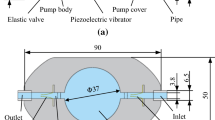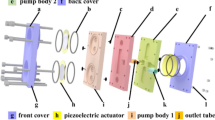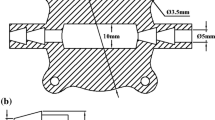Abstract
A new kind of piezoelectric pump with triple vibrators was presented. The pump adopted circular piezoelectric vibrator with a hole in the middle, and a check valve was adhered to the hole to cut off air. The working principle of the pump was analyzed. A prototype of piezoelectric pump was fabricated and measured. The experimental results show: (1) The maximum flow rate of the piezoelectric pump under the working mode of vibrators 1, and 3 driven synchronously and vibrator 2 driven asynchronously reached to 1513.2 mL/min when driving frequency was 220 Hz, and the maximum pressure reached to 4.08 kPa when that was 140 Hz. (2) The output performance of the piezoelectric pump with triple vibrators was the best under the working mode of vibrators 1, and 3 driven synchronously and vibrator 2 driven asynchronously. (3) When only two vibrators participate in working, the best connection method was vibrator 1 not driven and vibrators 2, and 3 driven asynchronously. (4) When only one vibrator participates in working, the best connection method was vibrator 3 driven solely.
Similar content being viewed by others
Avoid common mistakes on your manuscript.
1 Introduction
Piezoelectric pump is a kind of fluid-driving devices which uses inverse piezoelectric effect of piezoelectric ceramics to drive fluid in chamber and complete fluid delivery (Peng et al. 2009). Because piezoelectric pump has a series of advantages such as simple structure, small volume, no noise, no electromagnetic interference, etc., it has been applied in many aspects of modern society (Ma et al. 2008a, b, c, 2009; Jing-shi et al. 2007; Guo-jun et al. 2007).
Piezoelectric pump can be classified variedly, and it can be divided into single-chamber pump and multi-chamber pump (Kan et al. 2002) from single chamber number this aspect. Many scholars have studied the output performance of single-chamber pump and multi-chamber pump. Ma et al. (2008) proposed a diaphragm micro-pump with piezoelectric device. Its cross-section dimension is 28 mm × 5 mm. The measured maximum flow rate is 72 mL/min at zero total pump head in the range of operation frequency 70–180 Hz. De Lima et al. (2009) developed a biomimetic piezoelectric pump. By using an experimental prototype, it shows that the piezoelectric pump has achieved flow rate of 103 cm3/min for a frequency of 320 Hz and an applied voltage of 60 Vpp. Tai-jiang et al. (2009) designed double-chamber serial pump and parallel pump and tested. The experiment results indicated that the maximum flow rate of the double-chamber serial pump is 1150 mL/min in a sine wave voltage of 200 V and a frequency of 152 Hz, and that of double-chamber parallel pump is 640 mL/min in a sine wave voltage of 140 V and a frequency of 220 Hz. Jang et al. (2007) proposed a stand-alone peristaltic micropump with the package size of 22 × 12.8 × 9 cm. The experimental results show that it produces a maximum back pressure of 520 Pa with deionized water at 100 Vpp and 700 Hz. Zhang et al. (2013, 2015) developed a double-actuator piezoelectric pump with flow rate self-sensing capability. A prototype pump is fabricated with the size of 65 mm × 40 mm × 12 mm and tested. When the flow rate reaches the maximum value of 45.98 mL/min at 15 Hz, outlet/inlet sensing voltages also reach maximum values of 6.8 and 19.4 Vpp. The amplitude of piezoelectric pump is micron level, so the pressure difference formed in pump chamber is low and the delivery performance of single-chamber pump is limited. Therefore, it is necessary to study on the performance of multi-chamber piezoelectric pump. This article presents a piezoelectric pump with triple vibrators.
2 Structure design and working principle of piezoelectric pump with triple vibrators
2.1 Structure design
Figure 1 shows the structure of piezoelectric pump with triple vibrators which are composed of upper and lower cover, middle cover, rubber seals, piezoelectric vibrators, check valves, inlet and outlet. The pump chamber is sealed by rubber seals. The material of cover is polymethyl methacrylate. The corner is tightened by bolts. The piezoelectric vibrator used in this work is shown in Fig. 2 and is mainly comprised of piezoelectric ceramics bonded on a metal substrate with a hole in the middle. The valve is adhered to the through hole. The type of valve is a wheel cut-off valve, the corresponding physical map is shown in Fig. 3a, while the installation is shown in Fig. 3b. The wheel cut-off valve has three parts: the valve, spring beams, and retaining ring. After the wheel cut-off valve is installed, the valve controls the opening and closing of the valve hole. The presence of the spring beam ensures that the valve can translate as a whole without rotation when the valve opens. The spring can be directly bonded to retaining ring or sealed using rubber O-ring.
Configuration of the piezoelectric pump with triple vibrators. 1 wire A, 2 wire B, 3 wire C, 4 wire D, 5 wire E, 6 wire F, 7 wire G, 8 wire H, 9 wire I, 10 lower cover, 11 the first chamber, 12 inlet, 13 nut, 14 inlet chamber, 15 rubber seal, 16 the first piezoelectric vibrator (vibrator 1), 17 check valve I, 18 middle cover I, 19 the second piezoelectric vibrator (vibrator 2), 20 the second chamber, 21 check valve II, 22 middle cover II, 23 bolt, 24 upper cover, 25 check valve III, 26 outlet, 27 outlet chamber, 28 the third piezoelectric vibrator (vibrator 3)
2.2 Working principle
According to the different connection methods, the working principle of a piezoelectric pump with triple vibrators is also different. To be driven synchronously is to apply alternating voltage with the same phase to three piezoelectric vibrators at the same time; to be driven asynchronously is to apply alternating anti-phase voltage to the three piezoelectric vibrators. As shown in Fig. 1, the electrical connections of the vibrators under the working mode of vibrators 1, 2, and 3 driven synchronously are wires A, C, D, F, G, and I connected to the positive end and wires B, E, and H connected to the negative end. The electrical connections of the vibrators under the working mode of vibrators 1, and 2 driven synchronously and vibrator 3 driven asynchronously are wires A, C, D, F, and H connected to the positive end and wires G, I, B, and E connected to the negative end. The electrical connections of several other cases are not described in detail here.
The working principle of piezoelectric pump with triple vibrators driven synchronously is the same as that of piezoelectric pump with single-vibrator. It is no longer detailed.
Figure 4 shows working principle of piezoelectric pump with triple vibrators driven asynchronously (with the working mode of vibrators 1, and 3 driven synchronously and vibrator 2 driven asynchronously as an example). During suction mode, the first and third vibrator move down and check valves on them open due to inertia force and pressure difference. The second vibrator moves up and check valve II is closed. As a result, fluid flows from inlet chamber into the first chamber and fluid in the second chamber flows into outlet chamber; during pumping mode, the first and third vibrator move up and check valves on them are closed. The second vibrator moves down and check valve II opens due to inertia force and pressure difference. Fluid flows from the first chamber to the second chamber and fluid in the outlet chamber flows out of the pump. At the same time, fluid outside the pump flows into inlet chamber. Repeating the above process, fluid can form a directional flow.
Driven asynchronously of piezoelectric pump with triple vibrators also include vibrators 1, and 2 driven synchronously and vibrator 3 driven asynchronously as well as vibrators 2, and 3 driven synchronously and vibrator 1 driven asynchronously. The working principle is no longer detailed.
3 The simulation analysis of piezoelectric vibrator
The structural parameters of piezoelectric vibrator determine its inherent vibration mode. Modal analysis was taken to see inherent frequency and vibration modes of piezoelectric vibrator. It provides a reference for choosing appropriate driven frequency. Relative dimensions and material properties of piezoelectric vibrators are shown in Table 1. Entity model of piezoelectric vibrator is established, and fixed constraints are applied to outer edge of the annular beryllium substrate, and electric field constraints are applied to upper and lower surfaces of the piezoelectric ceramic. Figure 5 shows the vibration modes of piezoelectric vibrator. Table 2 lists the values of driven frequencies corresponding to the different modes.
The first mode is pure bending vibration and its deformation is arch. Deformation increases gradually from periphery to the center and it is symmetric. So it is suitable as a driven mode, and the piezoelectric vibrators should work at a frequency lower than that of the first mode.
4 Performance test of piezoelectric pump with triple vibrators
4.1 Experimental test
As shown in Fig. 6, performance test devices include power strip 1, soap film meter 2, signal generator 3, U type pressure gauge 4, piezoelectric pump 5, bracket 6 and rubber hose 7. The test medium is air.
4.2 Experimental results
As shown in Fig. 7, the output flow rate under the working mode of vibrators 1, and 2 driven synchronously and vibrator 3 driven asynchronously has a slight increase and being stable with the increasing frequency, and the output flow rate of the other three working modes increase progressively at first and then decrease substantially. The optimal working frequency and the maximum flow rate of the piezoelectric pump under working mode of vibrators 1, and 3 actuated synchronously and vibrator 2 driven asynchronously are 220 Hz and 1513.2 mL/min, respectively. This working mode is better than the other three modes. The flow rate under this working mode is close to that under the working mode of vibrators 2, and 3 driven synchronously and vibrator 1 driven asynchronously. The flow rate under the working mode of vibrators 1, and 2 driven synchronously and vibrator 3 driven asynchronously is the least. As shown in Fig. 8, the optimal working frequency and the maximum pressure under the working mode of vibrators 1, and 3 driven synchronously and vibrator 2 driven asynchronously are 140 Hz and 4.08 kPa, respectively. This working mode is better than the other three working modes and the pressure under the working mode of vibrators 1, and 2 driven synchronously and vibrator 3 driven asynchronously, and vibrators 1, 2, and 3 driven synchronously are lower.
As shown in Figs. 9 and 10, the output flow rates and pressures of six working modes increase progressively at first and then decrease substantially. As shown in Fig. 9, the output flow rate of the modes driven asynchronously are better than those driven synchronously, and the flow rate under the working mode of vibrator 1 not working and vibrators 2, and 3 driven asynchronously is higher, the optimal working frequency and the maximum flow rate under this working mode are 240 Hz and 1735.7 mL/min, respectively. The flow rate under the working mode of vibrator 3 not working and vibrators 1, and 2 driven synchronously is reduced. As shown in Fig. 10, the maximum pressure occurs under the working mode of vibrator 1 not working and vibrators 2, and 3 driven asynchronously, the optimal frequency and pressure are 160 Hz and 3.14 kPa respectively. The output pressure under the working mode of vibrators 2, and 3 driven asynchronously and vibrators 1, and 2 driven asynchronously are higher than those of the modes of them being driven synchronously, the pressure under the working mode of vibrator 1 not working and vibrators 2, and 3 driven asynchronously is the highest; the output pressure is the lowest under the working mode of vibrator 1 not working and vibrators 2, and 3 driven synchronously.
As shown in Fig. 11, the output flow rate of vibrator 3 working alone is the highest and the maximum flow rate is 1542.2 mL/min and it occurs at the frequency of 220 Hz. The output flow rate of vibrator 1 working alone is the least. As shown in Fig. 12, the output pressure of all the three working modes increase progressively at first and then decrease substantially with the frequency increasing. The output pressures of vibrator 2 working solely and vibrator 3 working solely are higher than that of vibrator 1 working solely.
5 Conclusions
We presented a novel piezoelectric pump with triple vibrators. The pump adopted circular piezoelectric vibrator which had a hole in the middle, and a check valve was adhered to the hole to cut off air. It is composed of upper and lower cover, middle cover, rubber seals, piezoelectric vibrators, check valves, inlet and outlet. Modal analysis was taken to see inherent frequency and vibration modes of piezoelectric vibrator. The results show the first mode is suitable as a driven mode and the piezoelectric vibrators should work at a frequency lower than that of the first mode. We produced a prototype and experimental tests of output performance were performed. The experimental results show: The maximum flow rate of the piezoelectric pump under the working mode of vibrators 1, and 3 driven synchronously and vibrator 2 driven asynchronously reached to 1513.2 mL/min when the driving frequency was 220 Hz, and the maximum pressure reached to 4.08 kPa when that was 140 Hz; The output performance of the piezoelectric pump with triple vibrators was the best under the working mode of vibrators 1, and 3 driven synchronously and vibrator 2 driven asynchronously; When only two vibrators participate in working, the best connection method was vibrator 1 not driven and vibrators 2, and 3 driven asynchronously; when only one vibrator participates in working, the best connection method was vibrator 3 driven solely. Compared with reference 1 and reference 2, the output flow rate of the piezoelectric pump has been improved.
References
de Lima CR, Vatanabe SL, Choi A et al (2009) A biomimetic piezoelectric pump: computational and experimental characterization[J]. Sens Actuators A 152(1):110–118
Guo-jun L, Zun-qiang F, Jing-shi D et al (2007) Piezoelectric micro pump for insulin injection[J]. J Jilin Univ Eng Technol Ed 37(2):372–376
Jang LS, Li YJ, Lin SJ et al (2007) A stand-alone peristaltic micropump based on piezoelectric actuation[J]. Biomed Microdevices 9(2):185–194
Jing-shi D, Guang-ming C, Chuan-liang S et al (2007) Piezoelectric insulin pump[J]. J Xi’an Jiaotong Univ 41(5):602–605
Kan JW, Yang Z, Cheng GM (2002) Research on piezoelectric pump and its development[J]. Optic Precis Eng 10(6):619–625
Ma HK, Hou BR, Wu HY et al (2008a) Development and application of a diaphragm micro-pump with piezoelectric device[J]. Microsyst Technol 14(7):1001–1007
Ma HK, Hou BR, Gao JJ et al (2008b) Development of one-sided actuating piezoelectric micropump combined with cold plate in a laptop. In: Semiconductor thermal measurement and management symposium, 2008. Semi-Therm, 24th Annual IEEE. IEEE, 2008, pp 124–131
Ma HK, Hou BR, Lin CY et al (2008c) The improved performance of one-side actuating diaphragm micropump for a liquid cooling system[J]. Int Commun Heat Mass Transfer 35(8):957–966
Ma HK, Chen BR, Gao JJ et al (2009) Development of an OAPCP-micropump liquid cooling system in a laptop[J]. Int Commun Heat Mass Transf 36(3):225–232
Peng TJ, Yang ZG, Cheng GM et al (2009) Design of double-chamber piezoelectric pump[J]. Optics Precis Eng 17(5):1078–1085
Zhang Z, Kan J, Wang S et al (2013) Flow rate self-sensing of a pump with double piezoelectric actuators[J]. Mech Syst Signal Process 41(1):639–648
Acknowledgments
The authors would like to acknowledge the financial support from Project No. 51405189 and No. 81171481 supported by National Natural Science Foundation of China, and the China Postdoctoral Science Foundation (No. 2014M551195).
Author information
Authors and Affiliations
Corresponding author
Rights and permissions
About this article
Cite this article
Dong, J.S., Chen, W.H., Zeng, P. et al. Design and experimental research on piezoelectric pump with triple vibrators. Microsyst Technol 23, 3019–3026 (2017). https://doi.org/10.1007/s00542-016-3029-6
Received:
Accepted:
Published:
Issue Date:
DOI: https://doi.org/10.1007/s00542-016-3029-6
















